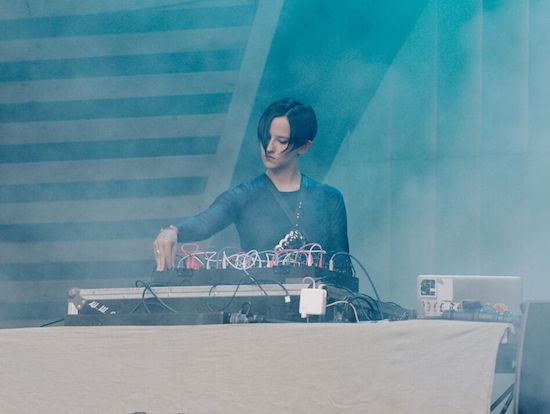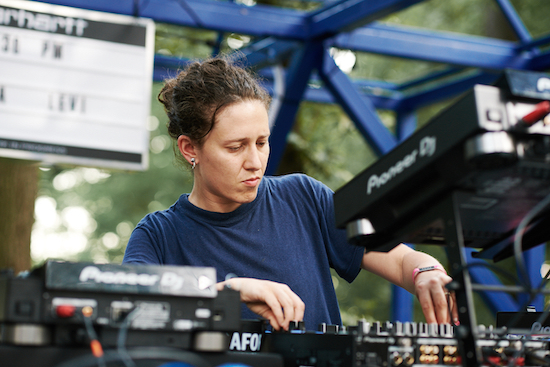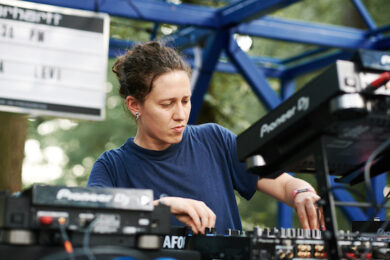Mica Levi by Francesco Margaroli
As Mica Levi’s understated yet stunning Saturday afternoon DJ set winds to a close, large drops of rain begin to fall from the sky. Revellers have just spent an hour dancing, laughing and crying in 30+ degree heat, so rain feels like relief. Some laugh and run through the rain, marking a surreal end to one of the best DJ sets I’ve ever heard – one that reminds me of how much I love feeling confused on the dancefloor, of why I go out to hear music in the first place. Levi finishes as it begins pissing it down; pellets of ice the size of my fingernails drop from the sky.
It’s July in Milan. The few weeks prior to Terraforma were absolutely sweltering; a heatwave nothing short of frightening brought extreme temperatures to Europe, including record-breaking highs in Germany, France, Poland and the Czech Republic. I return home after my brief internet break, back to the continuous slew of reports detailing forthcoming mass extinctions, approaching climate tipping points and so on and so forth.
Things are alarming, to say the very least. Conversations in music around our environmental impact and the climate crisis have felt sorely lacking – a novelty, rather than a norm. Thankfully, things seem to be changing, though this feels gradual and late.
Terraforma labels itself as a sustainable festival on the premise that "new dimensions can be terraformed.” So what are they terraforming here, exactly? They’re working to ensure diversity (though it seems that this is more apparent on their team, which is “nearly 50% female” than line-up). They actively work with co-operatives and NGOs to “professionally engage groups of refugees”. Their building process adopts a zero waste policy, reusing all excess material from the construction of their stages to create secondary facilities such as showers. The festival also contributes to the long-term recovery of Villa Arconati’s garden.
A pamphlet accompanying the festival outlines other efforts they’ve undertaken to be environmentally friendly, stating that “in a critical year for climate change, the audience will be asked to take action during the festival.” The action referred to here is using a reusable cup through the festival, allowing it to be a disposable plastic-free event. All of these efforts are certainly commendable and important, but how sustainable is this practice, exactly, and the culture that it’s a part of? While there’s substantially less litter here than at most other festivals I’ve been to, it’s still disheartening to see the amount of plastic and cigarette butts strewn about Villa Arconati. I see litter in the form of sustainability pamphlets. I think about how much most attendees actually engage with ethos here, and get the sense that the festival generally lacks urgency.
It appears only as a blip on day one. “Who will tell the story of the end,” asks Laurie Anderson at the start of her set on the festival’s opening night. She asks questions about storytelling and humanity’s potential lack of audience in the face of the climate crisis. She makes reference to rising temperatures, and leads us in a collective scream. It feels like the closest the festival comes to acknowledging just how much shit we’re in. She diverts course and, along with cellist Rubin Kodheli, meanders through the rest of her performance, adroitly weaving together storytelling, improvisation and even tai chi. We move on from fear, segueing from story to story, and the tension of her question dissipates. Will we be the first to have a story to tell nobody? We move on.
There’s much that feels special about Terraforma. Intimate and cleverly programmed, the festival plays host to a steady stream of distinctive performances across the weekend, and it takes place in one of the most gorgeous festival sites I’ve been lucky enough to witness. With only one act playing at a time, performances flow one into the next, and audience members drift from stage to stage. The gorgeous Labyrinth stage is a maze of shrubs in which warped wails and convoluted kick patterns courtesy of Monolake bounce and skitter. Sote, scheduled to play on the Saturday, has his performance cancelled due to hail. Over the weekend, the mainstage welcomes Stingray’s swampy electro and mechanical funk, Caterina Barbieri’s gorgeous synth melodies and Bambounou’s nimble rhythm and tempo gymnastics. Their sounds flow through the surrounding trees, complemented by artful, subtle lighting. We drift from fear on to joy and hedonism, which are complemented by some reassurance, too, in the form of biodegradable cutlery.

Caterina Barbieri by Francesco Margaroli
We drift on, attention drawn to music – how could one not be enamoured by the infectious joy of RP Boo or STILL? We think of the inconvenient hailstorm as another blip and move on from uncomfortable questions in favour of brief escapes, otherwise the scream Anderson leads us on would probably never end, or at least that’s my hunch. We choose not to sit with discomfort or fear. Instead of saturation in dystopian, fatalistic imagery, what if we grappled with discomfort and considered what we might learn from these troubles? Rather than indulging in dramatic, terrifying tales, what could these anxieties help catalyse?
Terraforma, a sustainable festival, wrestles with our tumultuous relationship with our planet – as should all of us. But for now, it feels like it lacks urgency in this pursuit. Maybe that’s suggested by the term itself; sustainability implies stasis, not interruption. But by now it feels like it’s not quite enough to adopt sustainable practices, that perhaps we’re in need of a radical change in direction. Perhaps culture and art could help us with this wrestling and become a site of plotting, concocting and dreaming up new ways of being here together. Maybe, beyond providing glimmers of escape, they could urge us to really interrogate how we live and how we go about in this world.
Of course, there’s talk of sustainability in music – as Chal Ravens’ excellent and thoughtful piece for RA describes, there are a number of efforts underway in our music bubble that aim to lessen our ecological impact, such as carbon offset initiatives, raising funds for coral reef preservation, minimising plastic waste and so on. But perhaps we could also consider maximising positive impact, too.
I don’t mean to belittle the pursuit of sustainable practices, but to advocate for culture that shifts how we think about and deal with responsibility and impact – to not flee from these frightening questions but to sit with them. While conversations around gender, race, representation and equality have propelled to the forefront of dance music culture in recent years, something substantial seems to be missing. We speak of inclusion and of “politics on the dancefloor,” yet overlook that it’s these already vulnerable groups who are made even more vulnerable by the climate crisis, which will come to amplify existing inequalities.
Sustainability can’t be achieved without drastically changing the ways in which we go about in this world. It can be easy to cynically dismiss the new age sentiments or romantic idealism that often colour narratives of transformation, but perhaps we could learn a thing or two from them. We don’t really have the time to be jaded – perhaps what we need from music is a little push in the direction of openness and vulnerability, to be able to collectively consider the urgencies of the climate crisis and the anxieties that plague us, to collaboratively develop ways forward together.



